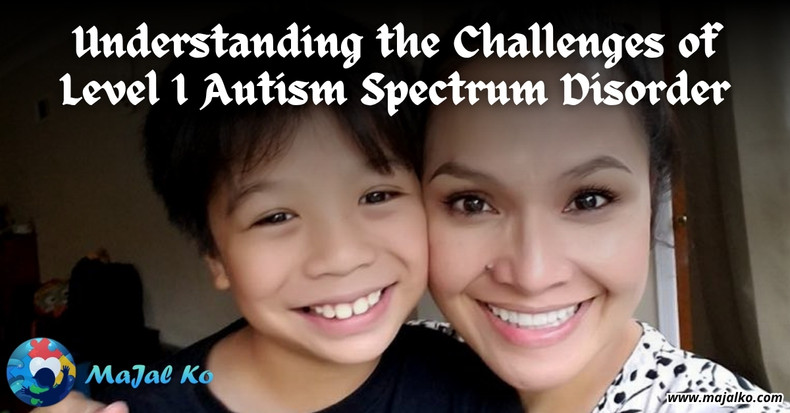Autism Spectrum Disorder (ASD) is a complex developmental condition that affects how individuals communicate, interact, and respond to their environments. Within this spectrum, Level 1 ASD—often referred to as "requiring support"—is the least severe in terms of support needs, but that does not mean it is without challenges. Families, educators, and healthcare providers often underestimate the daily struggles associated with Level 1 ASD, particularly because many individuals in this group can speak, learn, and work independently.
This blog takes a closer look at the specific challenges faced by individuals with Level 1 ASD and their families. By understanding the nature of these challenges, we can approach support with more empathy, accuracy, and effectiveness.
What is Level 1 Autism Spectrum Disorder?
According to the Diagnostic and Statistical Manual of Mental Disorders, Fifth Edition (DSM-5), Level 1 ASD is defined as requiring some support. Individuals in this category may have noticeable impairments in social communication and flexibility of behavior but can function without intensive assistance in many environments (American Psychiatric Association, 2013).
People with Level 1 ASD may:
-
Have difficulty initiating social interactions
-
Show atypical or unsuccessful responses in social settings
-
Struggle with transitions or changes in routine
-
Display rigid thinking or inflexible adherence to routines
-
Experience sensory sensitivities that interfere with daily life
Despite these issues, their language and cognitive development may appear typical in early childhood, which can lead to delays in diagnosis and support.
The Invisible Struggles
1. Social Fatigue and Anxiety
Although individuals with Level 1 ASD may appear socially engaged, the effort required to interpret social cues, maintain conversation, and regulate their responses is often exhausting. This "masking" behavior—where they consciously mimic neurotypical behaviors—can lead to significant internal stress, anxiety, and even burnout (Hull et al., 2017).
2. Misunderstood Behaviors
Because the symptoms may not be as overt as in individuals with higher support needs, behaviors like withdrawal, inflexibility, or bluntness are sometimes misread as intentional rudeness or laziness. This misunderstanding often leads to punishment, criticism, or social exclusion in school or work settings, rather than appropriate support.
3. Executive Function Difficulties
Level 1 ASD is often accompanied by challenges in executive functioning—such as planning, organizing, and managing time. While the individual may be academically capable, they may struggle to complete tasks that require multi-step planning or managing long-term projects.
4. Difficulty with Transitions
Changes in routine—whether it’s a schedule change, unexpected events, or even minor shifts in daily expectations—can provoke anxiety, confusion, or shutdowns. These responses are often misinterpreted as being dramatic or uncooperative when they are actually expressions of distress.
5. Sensory Processing Issues
Many individuals with Level 1 ASD experience sensory sensitivities—such as being overwhelmed by loud noises, bright lights, strong smells, or certain textures. These sensory challenges can affect everything from meal times to clothing choices, yet they are often dismissed or minimized by others due to a lack of visible symptoms.
Delayed Diagnosis and Lack of Services
Because children and adults with Level 1 ASD can speak and perform basic tasks independently, they are frequently diagnosed later in life—if at all. Girls, in particular, are underdiagnosed due to subtler social presentation and more effective masking (Lai et al., 2015).
Delayed diagnosis means missed opportunities for early intervention, social support, and accommodations. Even after diagnosis, individuals may not qualify for services designed for people with more obvious impairments, leaving them in a kind of support "gap."
Emotional Toll on Families
Families often experience confusion, frustration, and guilt when trying to support a child or adult with Level 1 ASD. Because the challenges are not always visible or easily explained, it can be difficult to access resources or convince others—including educators and clinicians—of the need for support.
Parents may report that their child is “fine at school but melts down at home,” a dynamic that adds to feelings of helplessness and isolation.
Moving Toward Understanding
To better support individuals with Level 1 ASD, there needs to be greater awareness that:
-
The absence of severe disability does not mean the absence of disability.
-
Social, sensory, and executive function challenges can be deeply disruptive even if hidden from view.
-
Emotional distress from masking and unmet needs can lead to depression, anxiety, and self-esteem issues.
Support strategies include structured routines, clear communication, flexible schooling or work arrangements, and access to professionals familiar with neurodiversity.
Conclusion
Level 1 Autism Spectrum Disorder presents with subtler symptoms compared to higher levels of support need, but its challenges are real and impactful. The condition may be hidden in plain sight, especially in children and adults who appear capable but are internally struggling. Awareness, validation, and thoughtful support—not judgment or dismissal—are what make the difference.
References
-
American Psychiatric Association. (2013). Diagnostic and Statistical Manual of Mental Disorders (5th ed.).
-
Hull, L., Mandy, W., & Petrides, K. V. (2017). Behavioural and cognitive sex/gender differences in autism spectrum condition and typically developing males and females. Autism, 21(6), 706–727.
-
Lai, M. C., Lombardo, M. V., Auyeung, B., Chakrabarti, B., & Baron-Cohen, S. (2015). Sex/gender differences and autism: setting the scene for future research. Journal of the American Academy of Child and Adolescent Psychiatry, 54(1), 11–24.
-
National Autistic Society. (2022). Levels of Autism
-
Centers for Disease Control and Prevention. (2020). Autism Spectrum Disorder (ASD): Symptoms and Diagnosis

